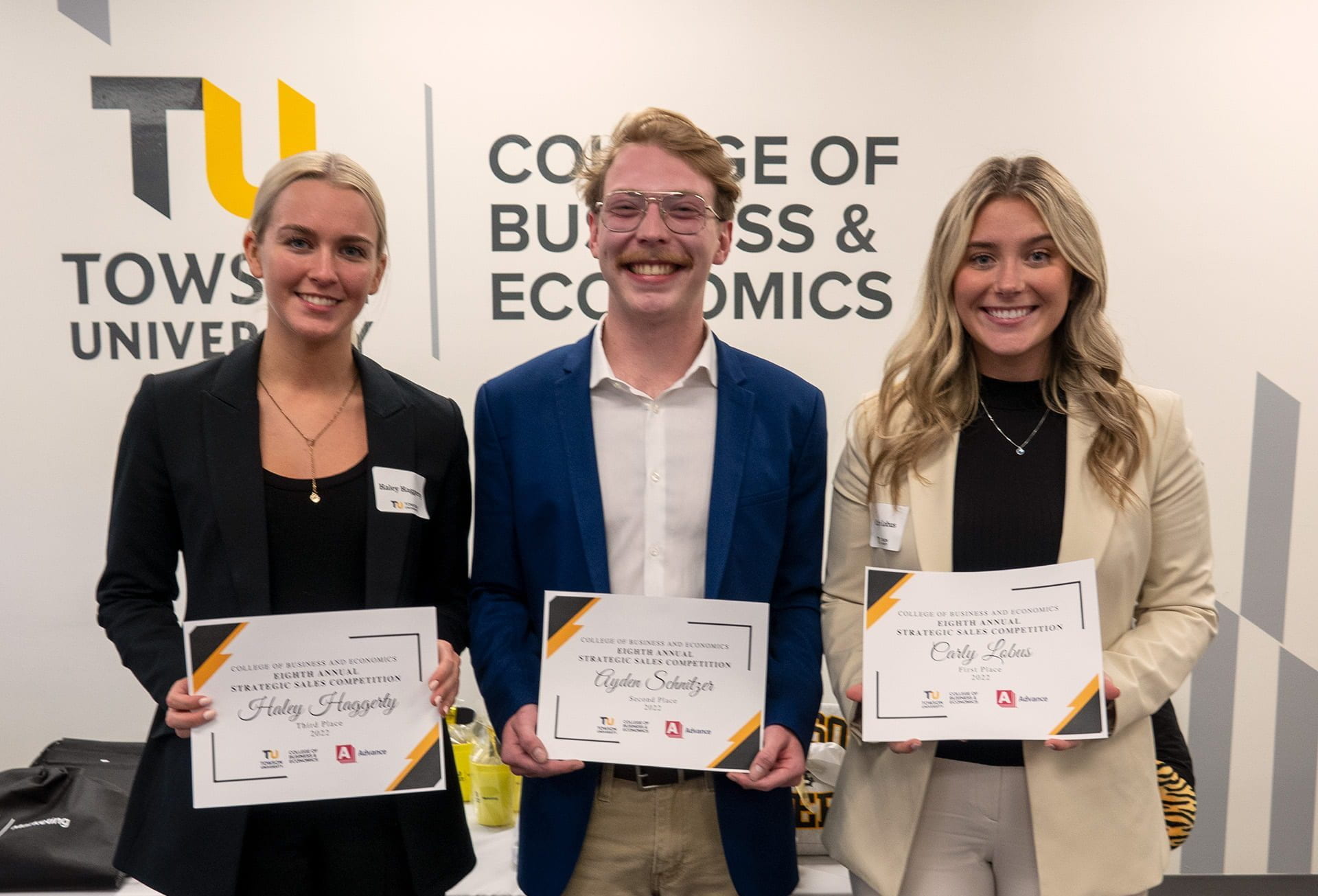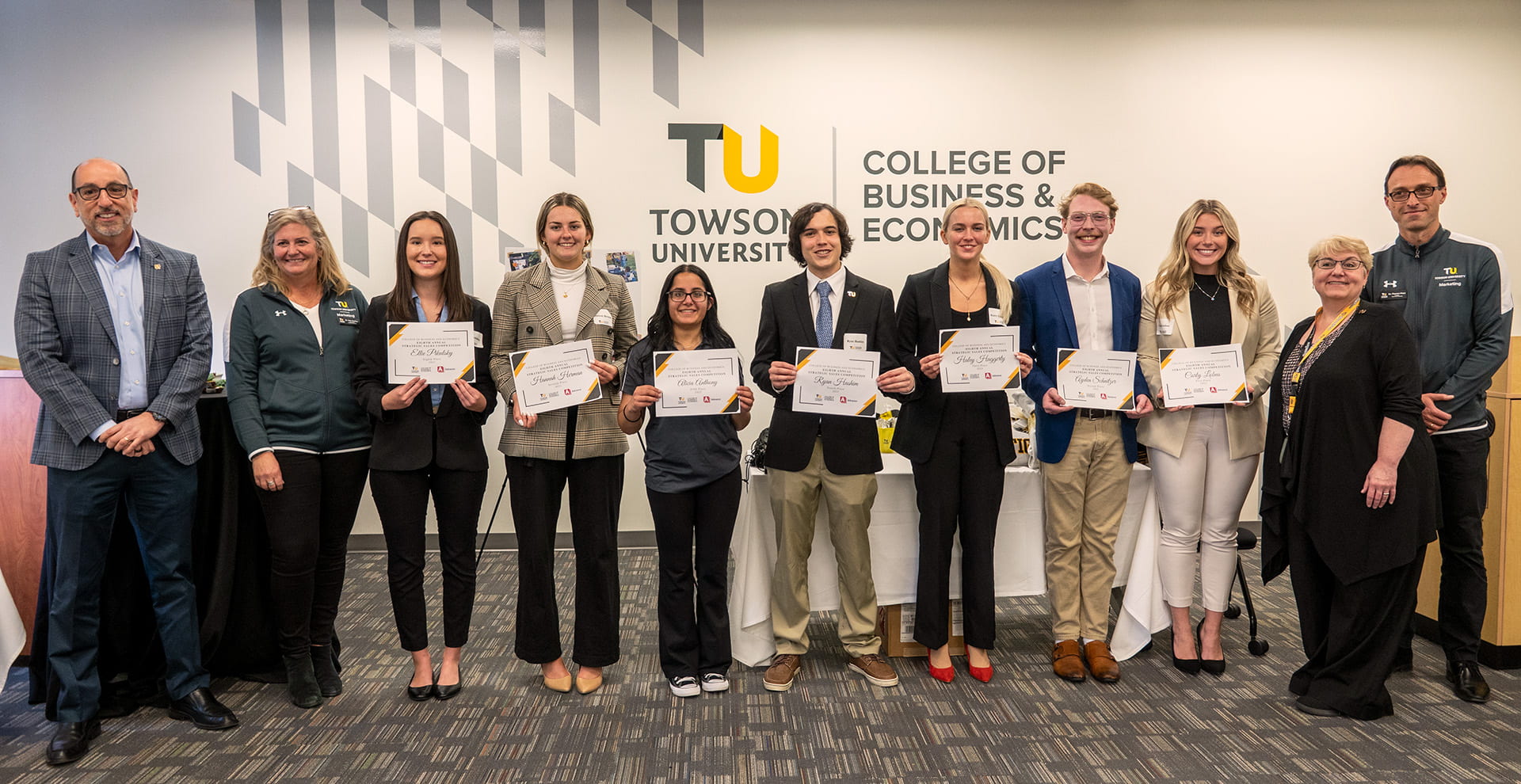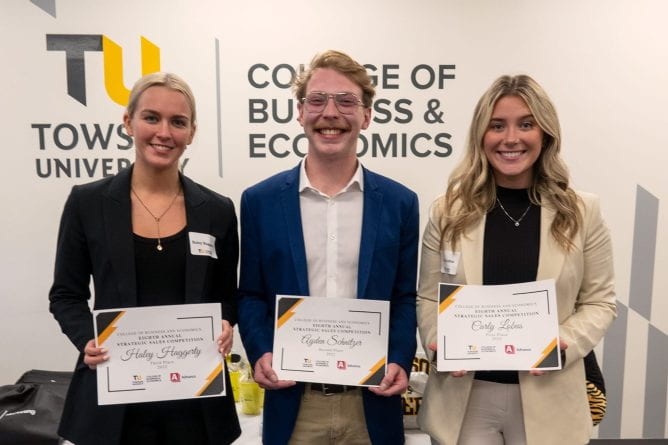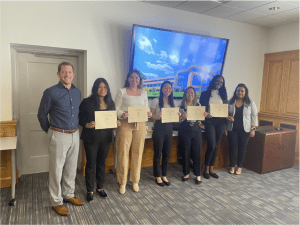On November 18, 2022, the Department of Marketing at Towson University held its 8th Annual Strategic Sales Competition. Nearly 60 students and 44 representatives from 13 corporate partners gathered to participate in the competition. Advance Business Systems, the platinum corporate sponsor for this year’s event, tasked the students with selling a package of various IT services offered by their company and served as “buyers” for the competition.
Representatives from Northwestern Mutual, United Electric Supply, Sherwin-Williams, Lower, MDP, Insight Global, Contour Mortgage, Enterprise, ADP, Chesapeake Plywood, Cvent, memoryBlue, and Stanley Black & Decker served as judges for the competition. Among the group of judges were several alumni including Kevin Carr ’87 (Cvent), Hailey Hardesty ‘19 (Enterprise), Alex Parker ’20 (Northwestern Mutual) and Joe Richardson ’98 (Stanley Black & Decker).
The Sales Competition is a great experience for students to gain hands on sales experience, as well as providing them with the opportunity to network with business professionals from the Towson area. Students from any major and class are welcome to participate, but students in MKTG 452 participate as part of their course.
“The Strategic Sales Competition provides the perfect environment to gather our best students and a large group of representatives of the regional business community. It is the perfect setting – the companies are looking to hire fresh talent and the students are looking for their first job after college,” Dr. Plamen Peev, professor of marketing and organizer of the competition, said. “The event grows every year and hopefully it will help elevate our sales program to where in the next few years we should be able to offer a sales certificate to TU students and establish a sales center within the College of Business and Economics,” he added.
In preparation for the competition, students were asked to develop a sales pitch for a potential buyer. During the competition, students enter a room with one buyer, introduce themselves, and then have 15 minutes to deliver their sales pitch.
When asked about how she prepared for the competition, first place winner Carly Lobus emphasized preparation and rehearsal. “You never know when you’re prepared enough, you never know when to stop,” she said. “My best advice is to practice with somebody, but don’t be too rehearsed.”

To replicate a “real-world” environment, the judges view the performances from a live stream in another room. From there they can evaluate students’ performances based on their delivery, tactics and ability to address the buyers’ concerns.


Advance is home to several Towson University alumni who represented the company during the competition as buyers. Hayley Beddard ’20, an account sales representative for Advance since June 2022, praised the students for their tenacity and hard work. “I think [the competition] just gives them good real-world experience and helps build some confidence, she said. “I know when I did it myself it was really nerve-wracking, and it took a lot of courage to do it.” Hayley graduated from Towson University in 2020 with a degree in business administration. Olivia Bushong ’15 joined Advance’s marketing and communications team immediately after graduating from Towson University with a degree in mass communications.
The judges selected eight winning students:
- Carly Lobus, Senior, Mass Communications
- Ayden Schnitzer, Senior, Business Administration, Management Concentration (Leadership & Management)
- Haley Haggerty, Senior, Business Administration, Marketing Concentration
- Ryan Hashim, Senior, Mass Communications, Marketing Minor
- Alicia Anthony, Junior, Mass Communications, Marketing Minor
- Josh Munley, Senior, Business Administration, Marketing Concentration
- Hannah Herman, Junior, Business Administration, Marketing Concentration
- Ellie Pikulsky, Senior, Business Administration, Marketing Concentration

Jeff Elkin, president of Advance, commended the students for their preparation and the quality of their pitches. “We thought the presentations were terrific. Students were clearly very prepared for it and had great training. We were very impressed,” he said. “My advice for future students is to prepare. Know the product. And be yourself.”
All eight winning students received scholarships up to $1,500 for their success in the competition. The top 5 students were also invited to represent Towson University at the National Shore Sales Challenge to be held at Salisbury University this spring.
For more information about the TU Strategic Sales Competition, please visit our website.



 Dr. Jorge Romero has been with the accounting department at the College of Business and Economics at Towson University since 2008. During this time, he has taught a variety of undergraduate and graduate classes, as well as undertaking some exciting research projects. I had the chance to speak with Dr. Romero and was able to gain some valuable insight into his career, the world of accounting, and what it is like to be a professor at Towson University.
Dr. Jorge Romero has been with the accounting department at the College of Business and Economics at Towson University since 2008. During this time, he has taught a variety of undergraduate and graduate classes, as well as undertaking some exciting research projects. I had the chance to speak with Dr. Romero and was able to gain some valuable insight into his career, the world of accounting, and what it is like to be a professor at Towson University. Raquel Tennant, a 2019 graduate of the College of Business and Economics, always had a knack for finance. Tennant always was making lists for her spendings and math came easy to her. Despite this, Tennant did not like the abstract nature of the subject and wanted something that could be applied to everyday people. When she found
Raquel Tennant, a 2019 graduate of the College of Business and Economics, always had a knack for finance. Tennant always was making lists for her spendings and math came easy to her. Despite this, Tennant did not like the abstract nature of the subject and wanted something that could be applied to everyday people. When she found 

